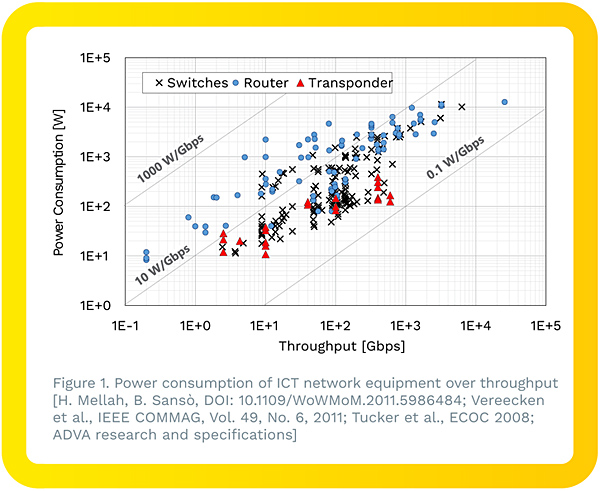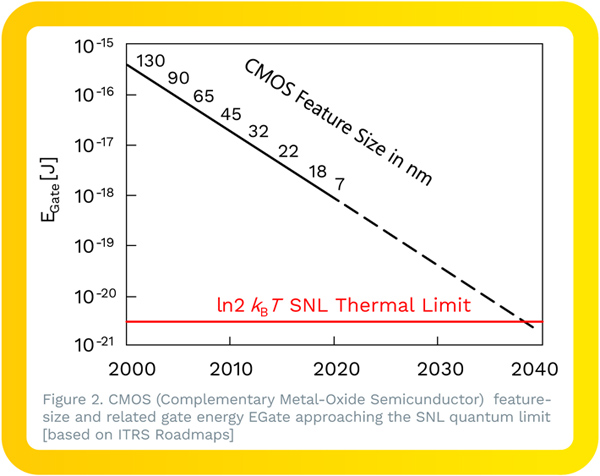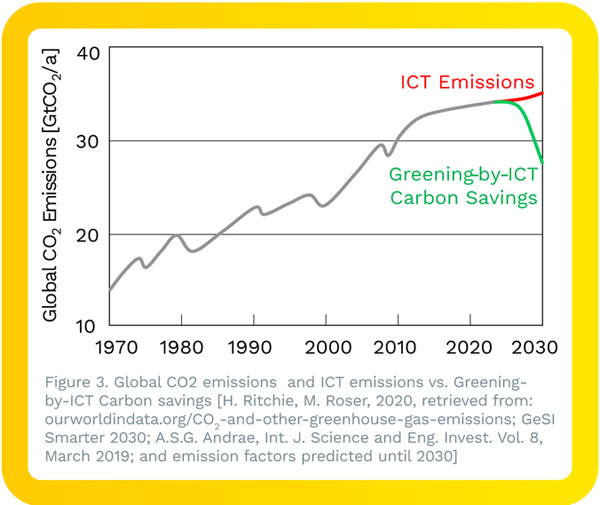Introduction
Since the global ramp-up of the
Internet, its throughput and the
associated bitrates have been
growing exponentially. This can be
extracted from the most important
reference for Internet throughput, the
Cisco Visual Networking Index.
Main components of the Internet
or ICT sector (information and
communication technology) are
wired and wireless networks, data
centers, and end-user equipment.
The networks that connect users and
data centers account for ~25% of the
total resulting energy consumption
and associated emissions. They
split into core and access parts.
The core networks consist of
aggregation switches, routers and
fiber-optic wavelength-domain
multiplexing (WDM) transport. For
these equipment classes, some 80-
90% of the environmental impact
are determined by the use-phase
power consumption, which can be
derived from lifecycle analyses. This
is particularly true for the global
warming potential (GWP).
Energy and emissions
The bandwidth growth leads to an
increase in ICT power consumption,
in particular for data centers and
networks. The increasing power
consumption also leads to increasing
Carbon emissions.
Given the threats of global warming
and also general resource depletion,
the ICT environmental-impact growth
must be seen critical.
ICT equipment got more powerefficient
over time. However, it
also had to cope with the growing
bandwidths of an increasing number
of bandwidth-hungry applications.
For the core-network equipment
(switches, routers, and WDM
transponders), it has not been
possible to cope with this bandwidth
growth by gains in power efficiency:
as a result, core-network equipment,
over time, consumes more power.
This is shown in Figure 1.

Power efficiency also massively grew.
In Figure 1, this can be seen because all
equipment shown develops toward
isolines of constant and improving
power efficiencies of 1000 → 0.1 W/
Gbps (Watts per Gigabit-per-second).
Our latest WDM equipment, for
example, can achieve an efficiency of
almost 0.2 W/Gbps.
In addition to bandwidth growth,
which will likely sustain over the next
couple of years, we are approaching
another area of challenge. The
increase of energy efficiency in
electronic switching and fiber-optic
transport is approaching some
fundamental limits in the next 20
years or so. Ultimately, for both,
switching and photonic transport, this
will be the so-called Shannon-von
Neumann-Landauer (SNL) thermal
limit, as shown in Figure 2. The SNL limit
is posed by quantum physics.

The practical consequence is the end
of density scaling in semiconductors.
Without new, disruptive
developments, the minimum switch
size will stop somewhere close to 5
nm. This will have effects on future
energy efficiency.
In addition, further saturation
effects already became visible. As a
consequence, there has been strong
increase in power consumption for
the highest-ranking high-performance
computing machines over the last four decades (from ~150 kW around
1980 via ~700 kW in 2005 to 17 MW in 2014).
Storage equipment in data centers is
facing saturation effects as well. The
main media for mass storage – tape,
hard-disk drives (HDD) and optical
disks – show slowed-down increase
in further areal density. The latter
is relevant for resource efficiency.
For HDDs, there is also an effect on
energy efficiency.
Disruptive new developments are
not clear right now. Theoretically,
concepts like entropy-preserving
switching or thermodynamically
reversible computing can break
the SNL limit, but they may not be
acceptable in practice because the
energy advantage comes at the cost
of switching speed.
Other technologies like carbon
nanotubes or biological-cell
processors may allow to get closer
to the SNL limit than today’s CMOS
technology. However, they do not yet
present mature technology.
There is one important aspect
that can relax the emissions
situation that results from the
ICT power consumption. This
aspect is sometimes referred to
as Greening-by-ICT. It refers to
emissions savings in sectors other
than ICT that are enabled by ICT
through respective digitalization.
The most relevant sectors that can
be significantly improved regarding
power consumption and emissions
are manufacturing, energy (e.g., the
power grids), buildings, mobility, and
agriculture. According to GeSI Smarter
2030, the carbon-saving effect on a
global scale can be almost a factor
of 10 higher than the ICT emissions
themselves. This is indicated in Figure 3.
It shows global Carbon emissions
with ICT emissions and the potential
Greening-by-ICT Carbon savings.

Conclusion
ICT networks have certain
environmental impact that is
currently not fully avoidable
despite all attempts for maximum
efficiency. However, the ICT sector
has very strong potential for Carbon
abatement in various other sectors.
These Greening-by-ICT effects are a
clear opportunity on the way toward
Carbon neutrality. It is therefore
likely that we need even more ICT to
exploit more Greening-by-ICT.
Contact details:
Dr. Klaus Grobe
ADVA Optical Networking SE
Fraunhoferstr. 9a
82152 Martinsried, Germany
Email: KGrobe@ADVAoptical.com